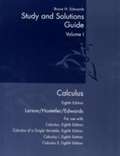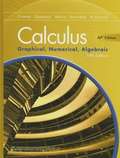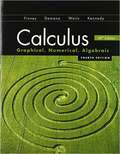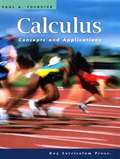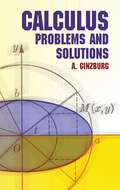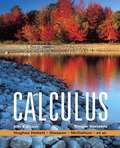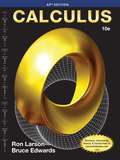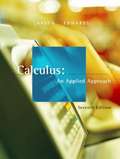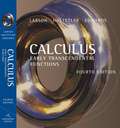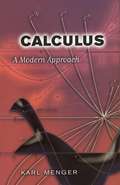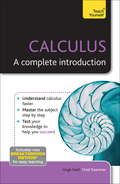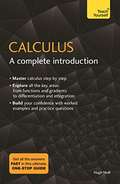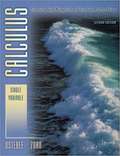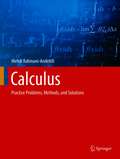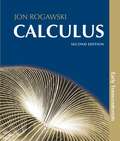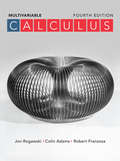- Table View
- List View
Calculus: Study Solutions and Guides
by Bruce H. EdwardsSolutions to all odd-numbered text exercises in Chapters P-10.
Calculus: Graphical, Numerical, Algebraic
by Ross L. FinneyThis text, as the edition before it, was especially designed and written for teachers and students of Advanced Placement Calculus. Combining the scholarship of Ross Finney and Frank Demana, the technological expertise of Bert Waits, and the intimate knowledge of and experience with the Advanced Placement Program of Dan Kennedy, this text is truly unique among calculus texts. It may be used, in perfect order and without supplementation, from the first day of the course until the day of the AP* exam. Teachers who are new to teaching calculus, as well as those who are very experienced, will be amazed at the insightful and unique treatment of many topics.
Calculus: Graphical, Numerical, Algebraic
by Ross L. Finney Franklin D. Demana Bert K. WaitsNIMAC-sourced textbook
Calculus: Graphical, Numerical, Algebraic
by Ross L. Finney Franklin D. Demana Bert K. Waits Daniel KennedyThis revision of Finney Thomas Demana Waits Calculus completely supports the content, goals, and philosophy of the new advanced placement calculus course description. The text includes a rich array of interesting applications in biology, business, chemistry, economics, engineering, finance, physics, the social sciences, and statistics.
Calculus: Graphical, Numerical, Algebraic
by Ross L. Finney Franklin D. Demana Bert K. Waits Daniel KennedyThe esteemed author team is back with a fourth edition of Calculus: Graphing, Numerical, Algebraic written specifically for high school students and aligned to the guidelines of the AP Calculus exam. The new edition focuses on providing enhanced student and teacher support; for students, the authors added guidance on the appropriate use of graphing calculators and updated exercises to reflect current data. For teachers, the authors provide lesson plans, pacing guides, and point-of-need answers throughout the Teachers Edition and teaching resources. Learn more.
Calculus: Concepts and Applications (2nd edition)
by Paul A. FoersterThe acclaimed Calculus: Concepts and Applications is now available in a new edition, revised to reflect important changes in the Advanced Placement curriculum, and updated to incorporate feedback from instructors throughout the U. S. With over 40 years of experience teaching AP Calculus, Paul Foerster developed Calculus: Concepts and Applications with the high school student in mind, but with all the content of a college-level course. Like the previous edition, the second edition follows the AP Calculus curriculum for both AB and BC levels. In Calculus: Concepts and Applications, students start off with calculus! Review of precalculus occurs at various points when itâ s needed. The text combines graphing-calculator technology with a unique, real-world application approach, and presents calculus as a study of just four fundamental concepts: limits, derivatives, definite integrals, and indefinite integrals. Students learn these concepts using algebraic, numerical, graphical, and verbal approaches. As a result, students with a wider range of abilities can be successful in calculus, not just those who are strong in algebra. The accompanying set of Explorations in the Instructorâ s Resource Book, designed for cooperative group work, gives students hands-on experience with new topics before they are formally introduced. In this new edition, derivatives of transcendental functions, related rates, as well as area and volume applications of the definite integral are introduced earlier. Additionally, the Instructorâ s Resource Book includes projects utilizing the CBLâ ¢, The Geometerâ s Sketchpad ®, and Fathom Dynamic Statisticsâ ¢ software, giving students extended opportunities to explore and understand calculus in depth
Calculus: Problems and Solutions
by A. GinzburgIdeal for self-instruction as well as for classroom use, this text helps students improve their understanding and problem-solving skills in analysis, analytic geometry, and higher algebra. More than 1,200 problems appear in the text, with concise explanations of the basic notions and theorems to be used in their solution. Many are followed by complete answers; solutions for the others appear at the end of the book. Topics include sequences, functions of a single variable, limit of a function, differential calculus for functions of a single variable, fundamental theorems and applications of differential calculus, the differential, indefinite and definite integrals, applications of the definite integral, and infinite series.
Calculus: Single Variable (5th Edition)
by Deborah Hughes-Hallett Karen R. Rhea Andrew Pasquale Sheldon P. Gordon Douglas Quinney Patti Frazer Lock Deborah Hughes Hallett Andrew M. Gleason William G. Mccallum David O. Lomen David Lovelock Jeff Tecosky-Feldman Thomas W. Tucker Daniel E. Flath Joseph ThrashThe fifth edition of Calculus brings together the best of both new and traditional curricula in an effort to meet the needs of even more instructors teaching calculus. The author team's extensive experience teaching from both traditional and innovative books and their expertise in developing innovative problems put them in an unique position to make this new curriculum meaningful to students going into mathematics and those going into the sciences and engineering. Calculus: Single Variable, 5e exhibits the same strengths from earlier editions including the Rule of Four, an emphasis on modeling, exposition that students can read and understand and a flexible approach to technology. The conceptual and modeling problems, praised for their creativity and variety, continue to motivate and challenge students. The fifth edition includes even more problems and additional skill-building exercises.
Calculus: 1,001 Practice Problems For Dummies (+ Free Online Practice)
by Patrick JonesPractice makes perfect--and helps deepen your understanding of calculus 1001 Calculus Practice Problems For Dummies takes you beyond the instruction and guidance offered in Calculus For Dummies, giving you 1001 opportunities to practice solving problems from the major topics in your calculus course. Plus, an online component provides you with a collection of calculus problems presented in multiple-choice format to further help you test your skills as you go. Gives you a chance to practice and reinforce the skills you learn in your calculus course Helps you refine your understanding of calculus Practice problems with answer explanations that detail every step of every problem The practice problems in 1001 Calculus Practice Problems For Dummies range in areas of difficulty and style, providing you with the practice help you need to score high at exam time.
Calculus
by Ken Binmore Joan DaviesThe pebbles used in ancient abacuses gave their name to the calculus, which today is a fundamental tool in business, economics, engineering and the sciences. This introductory book takes readers gently from single to multivariate calculus and simple differential and difference equations. Unusually the book offers a wide range of applications in business and economics, as well as more conventional scientific examples. Ideas from univariate calculus and linear algebra are covered as needed, often from a new perspective. They are reinforced in the two-dimensional case, which is studied in detail before generalisation to higher dimensions. Although there are no theorems or formal proofs, this is a serious book in which conceptual issues are explained carefully using numerous geometric devices and a wealth of worked examples, diagrams and exercises. Mathematica has been used to generate many beautiful and accurate, full-colour illustrations to help students visualise complex mathematical objects. This adds to the accessibility of the text, which will appeal to a wide audience among students of mathematics, economics and science.
Calculus: An Intuitive and Physical Approach (Second Edition) (Dover Books on Mathematics)
by Morris KlineApplication-oriented introduction relates the subject as closely as possible to science. In-depth explorations of the derivative, the differentiation and integration of the powers of x, and theorems on differentiation and antidifferentiation lead to a definition of the chain rule and examinations of trigonometric functions, logarithmic and exponential functions, techniques of integration, polar coordinates, much more. Clear-cut explanations, numerous drills, illustrative examples. 1967 edition. Solution guide available upon request.
Calculus
by Ron Larson Bruce EdwardsThe Larson CALCULUS program has a long history of innovation in the calculus market. It has been widely praised by a generation of students and professors for its solid and effective pedagogy that addresses the needs of a broad range of teaching and learning styles and environments. Each title is just one component in a comprehensive calculus course program that carefully integrates and coordinates print, media, and technology products for successful teaching and learning.
Calculus
by Ron Larson Bruce EdwardsThis edition clearly presents and effectively demonstrates the concepts and rules of calculus using a thoroughly updated learning experience specifically designed to remove any typical barriers to learning. New "Big Ideas of Calculus" notes present the overarching ideas behind chapter topics, while annotated examples and "Concept Checks" further reinforce your understanding. Step-by-step solution videos, exercise solutions and other tutorial support are available at no cost from CalcView.com, CalcChat.com and LarsonCalculus.com. In addition, new automatically graded Proof Problems with instant feedback, Expanded Problems and "Explore It" interactive learning modules within WebAssign digital resources help you develop a deeper conceptual understanding of calculus to succeed in this course and beyond.
Calculus: An Applied Approach
by Ron Larson Bruce H. Edwards David C. FalvoDesigned specifically for the non-math major who will be using calculus in business, economics, or life and social science courses, Calculus: An Applied Approach, 7/e, addresses students' weak math skills through added structure and guidance on how to study math. Special student-success-oriented sections include chapter-opening Strategies for Success; What You Should Learn--and Why You Should Learn It; Section Objectives; Chapter Summaries and Study Strategies; Try Its; Study Tips; and Warm-Up exercises. In addition the text presents Algebra Tips at point of use and Algebra Review at the end of each chapter. A strong support package includes the CL MATHSpace CD-ROM--which further emphasizes algebra review--and Instructional DVDs that allow students to review material outside of class.
Calculus: Early Transcendental Functions
by Ron Larson Robert Hostetler Bruce H. EdwardsDesigned for the three-semester engineering calculus course, Calculus: Early Transcendental Functions, 4/e, continues to offer instructors and students innovative teaching and learning resources. Two primary objectives guided the authors in the revision of this book: to develop precise, readable materials for students that clearly define and demonstrate concepts and rules of calculus; and to design comprehensive teaching resources for instructors that employ proven pedagogical techniques and save time. The Larson/Hostetler/Edwards Calculus program offers a solution to address the needs of any calculus course and any level of calculus student. Every edition from the first to the fourth of Calculus: Early Transcendental Functions, 4/e has made the mastery of traditional calculus skills a priority, while embracing the best features of new technology and, when appropriate, calculus reform ideas. Now, the Fourth Edition is part of the first calculus program to offer algorithmic homework and testing created in Maple so that answers can be evaluated with complete mathematical accuracy.
Calculus: A Modern Approach
by Karl MengerOne of the twentieth century's most original mathematicians and thinkers, Karl Menger taught students of many backgrounds. In this, his radical revision of the traditional calculus text, he presents pure and applied calculus in a unified conceptual frame, offering a thorough understanding of theory as well as of the methodology underlying the use of calculus as a tool.The most outstanding feature of this text is the care with which it explains basic ideas, a feature that makes it equally suitable for beginners and experienced readers. The text begins with a "mini-calculus" which brings out the fundamental results without recourse to the notions of limit and continuity. The standard subject matter is then presented as a pure and unambiguous calculus of functions. The issues surrounding the applications of pure calculus to problems in the sciences are faced in a forthright manner by carefully analyzing the meaning of "variable quantity" and clarified by resuscitating Newton's concept of fluents. The accompanying exercises are original, insightful and an integral part of the text. This Dover edition features a new Preface and Guide to Further Reading by Bert Schweizer and Abe Sklar.
Calculus: A Complete Introduction (Teach Yourself)
by Hugh NeillCalculus: A Complete Introduction is the most comprehensive yet easy-to-use introduction to using calculus. Written by a leading expert, this book will help you if you are studying for an important exam or essay, or if you simply want to improve your knowledge. The book covers all areas of calculus, including functions, gradients, rates of change, differentiation, exponential and logarithmic functions and integration. Everything you will need to know is here in one book. Each chapter includes not only an explanation of the knowledge and skills you need, but also worked examples and test questions.
Calculus: Teach Yourself Ebook
by Hugh NeillCalculus: A Complete Introduction is the most comprehensive yet easy-to-use introduction to using calculus. Written by a leading expert, this book will help you if you are studying for an important exam or essay, or if you simply want to improve your knowledge. The book covers all areas of calculus, including functions, gradients, rates of change, differentiation, exponential and logarithmic functions and integration. Everything you will need to know is here in one book. Each chapter includes not only an explanation of the knowledge and skills you need, but also worked examples and test questions.
Calculus: The Easy Way to Learn Calculus
by Hugh NeillCalculus: A Complete Introduction is the most comprehensive yet easy-to-use introduction to using calculus. Written by a leading expert, this book will help you if you are studying for an important exam or essay, or if you simply want to improve your knowledge. The book covers all areas of calculus, including functions, gradients, rates of change, differentiation, exponential and logarithmic functions and integration. Everything you will need to know is here in one book. Each chapter includes not only an explanation of the knowledge and skills you need, but also worked examples and test questions.
Calculus: From Graphical, Numerical, and Symbolic Points of View : Single Variable
by Arnold Ostebee Paul ZornOstebee and Zorn provide concrete strategies that help students understand and master concepts in calculus. This user-friendly text continues to help students interact with the main calculus objects (functions, derivatives, integrals, etc.) not only symbolically but also, where appropriate, graphically and numerically. Ostebee/Zorn strikes an appropriate balance among these points of view, without overemphasizing any of them. New exercises, examples, and much more have added tremendously to this great book.
Calculus: Practice Problems, Methods, and Solutions
by Mehdi Rahmani-AndebiliThis study guide is designed for students taking courses in calculus. The textbook includes practice problems that will help students to review and sharpen their knowledge of the subject and enhance their performance in the classroom. Offering detailed solutions, multiple methods for solving problems, and clear explanations of concepts, this hands-on guide will improve student’s problem-solving skills and basic understanding of the topics covered in their calculus courses.Exercises cover a wide selection of basic and advanced questions and problems;Categorizes and orders the problems based on difficulty level, hence suitable for both knowledgeable and under-prepared students;Provides detailed and instructor-recommended solutions and methods, along with clear explanations;Can be used along with core calculus textbooks.
Calculus: Early Transcendentals
by Jon RogawskiWhat's the ideal balance? How can you make sure students get both the computational skills they need and a deep understanding of the significance of what they are learning? With your teaching--supported by Rogawski's Calculus Second Edition--the most successful new calculus text in 25 years! Widely adopted in its first edition, Rogawski's Calculus worked for instructors and students by balancing formal precision with a guiding conceptual focus. Rogawski engages students while reinforcing the relevance of calculus to their lives and future studies. Precise mathematics, vivid examples, colorful graphics, intuitive explanations, and extraordinary problem sets all work together to help students grasp a deeper understanding of calculus. Now Rogawski's Calculus success continues in a meticulously updated new edition. Revised in response to user feedback and classroom experiences, the new edition provides an even smoother teaching and learning experience.
Calculus: Early Transcendentals
by Jon Rogawski Colin Adams Robert FranzosaWe see teaching mathematics as a form of story-telling, both when we present in a classroom and when we write materials for exploration and learning. The goal is to explain to you in a captivating manner, at the right pace, and in as clear a way as possible, how mathematics works and what it can do for you. We find mathematics to be intriguing and immensely beautiful. We want you to feel that way, too.
Calculus: Early Transcendentals
by Jon Rogawski Colin Adams Robert FranzosaWe see teaching mathematics as a form of story-telling, both when we present in a classroom and when we write materials for exploration and learning. The goal is to explain to you in a captivating manner, at the right pace, and in as clear a way as possible, how mathematics works and what it can do for you. We find mathematics to be intriguing and immensely beautiful. We want you to feel that way, too.
